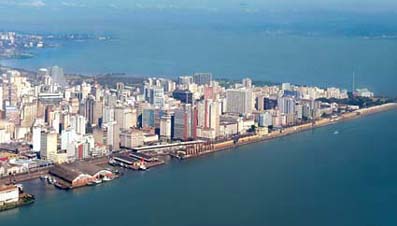 |
Porto Alegre is the most southern Brazilian capital. Located in Rio Grande do Sul State, it is the home of the legendary Gaucho. In Hollywood Gauchos became known as great latin lovers, buy here they are considered mostly as a kind of brazilian cowboys. Farms, cows and horses, this is home for them. Even so, don't expect to find horses and cows on Porto Alegre streets. In fact, this city, eestablished 250 years ago next to Guaiba River, is considered one of the best places in Brazil for living.
Video: Landing in Porto Alegre |
Porto Alegre is a vibrant and modern town, where strong cultural habits are still present, some of them easy to notice when walking around, like Chimarrao, a kind of hot tea. After all, this is Gaucho homeland, and Porto Alegre is the first step to learn everything about him, and enjoy all the good things Rio Grande State has to offer.
At right, the Monumento ao Laçador, representing the well known Brazilian Gaucho. It is located near Porto Alegre International Airport, and soon became a famous city landmark as well as the most wanted item in souvenirs stores. Start your gaucho tour visiting one of the many CTG´s (Centro de Tradicao Gaucha) in town, the rigth place for hearing some music, watching traditional dances and Gaucho traditions. Rio Grande do Sul is also known as home of the best barbecues in Brazil. Here, preparing them is considered not only an art but also a local specialty. On Sundays you can usually smell it from everywhere in town. At night the right place to is at Moinhos de Vento (Windmills) quarter, where are some of the most refined and fashioned restaurants, bars, coffee shops, and dance clubs. |
 |
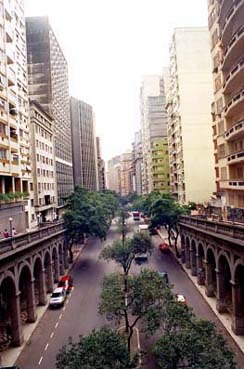 |
Walking in the streets of Porto Alegre is going up and down at every moment. From the first settlement next to Guaiba River, the city extended to the nearby area, including many hills (coxilhas, in gaucho language). There are at least forty in the central area.
AT the top of the main city hill you will find Piratini Palace, home of the state government, a classic Louis VXI style building, designed by French architect Maurice Gras, and with interior adorned by famous Italian painter Aldo Locatelli, showing scenes from Negrinho do Pastoreio, the well known gaucho legend.
At left, Viaduto da Borges de Medeiros, a traditional lankmark in Porto Alegre. |
Next to the palace is Catedral Metropolitana, the city catholic cathedral, with towers inspired on the churches built by the first Portuguese priests than came to Brazil in the 16th century. Its 230 feet high and 55 feet diameter Dome is one the largest in the world. |
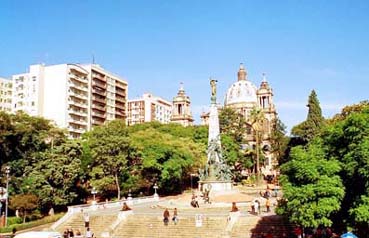 |
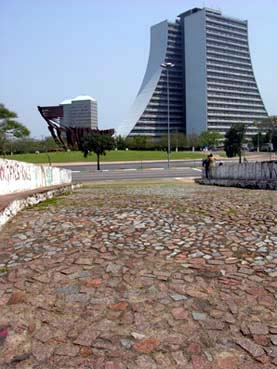 |
The stone paved bridge you see on this picture is one of the oldest in town, the historic Ponte dos Acorianos. It is one of the city historic landmarks, and used to link downtown to the northern part of the city, where the great farms were once located. At the right edge, you can see the Acorianos Monument, built to remember all those who, almost three centuries ago, came from the Acores Islands, Portugal, crossing the south Atlantic ocean, looking for a new world, and would become be the first settlers of Porto Alegre. It was build in a ship shape to remember and honor those first 60 couples who decided to start a new life in this same place.
Just a short walk from this point will take you to Parque Marinha do Brasil (Brazilian Navy Park), not a military area as it may sounds, but actually one of the best parks in town, famous for being the number one spot to watch the sunset on the Guaiba river.
|
Those looking for some real gaucho items and souvenirs, go to the Central Market (right). Among the most popular items you will find there are tons delicious home made fruit jams and creams prepared by the German settlers from west Rio Grande, great red and white wines from the northern gaucho mountains, a wide selections of cheese and special meats prepared by the Italian settlers, as well fruits and chocolate candies from the city of Pelotas. And also authentic Gaucho outfits, of course.... |
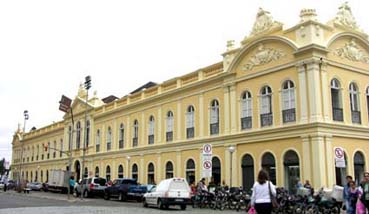 |
 |
At left, picture from inside Central Market, located downtown. The Central Market building is itself an attraction. It was built in 1869, on neoclassical style, and was almost demolished some years ago. Instead, the city decided for a complete remodeling of its interior, maintaining the outside part exactly how it was 150 years ago. Today, it is not only a showcase of Rio Grande do Sul traditional dishes and culture, but also a landmark in town. Try also its delicious ice creams, found at store #40, and the delicatessen from store #38. |
In Porto Algre, old time traditions are all kept alive and well in the many CTG (portuguese for Gaucho Traditional heritage centers) in Porto Alegre. Some of the most traditional gaucho dances are the Tirana, Balaio, Pezinho e Pau de Fita. Also the Chula is an old traditional musical challenge, where two defiants must accomplish elaborate movements, dancing over a stick on the ground, without touching it. And please, during your Gaucho afternoon, do not forget to try the Chimarrao, a kind of hot tea always served in Porongos, the Gaucho Mug. At right, Santa Tereza Mountain, located just in front of International Footbal Club stadium. |
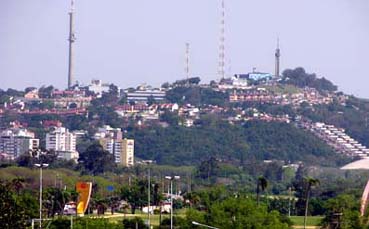 |
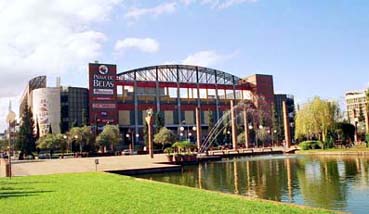 |
Wanna do some shopping? No trouble. You will be able to choose from Shopping Iguatemi (1800 Joao Wallig Ave, the largest in town), Bourbon Shopping (5200 Ipiranga Ave), Lindoia Shopping (3522 Assis Brasil Ave) and Praia de Belas Mall (left photo). |
The most fashionable place in the heart of the city is Rua da Praia (Beach street), the crowded commercial downtown area. The beach is gone long ago, but the name remains, and next to it you will find many attractions which tell the story of south Brazil. Visit Memorial do Rio Grande do Sul (1020, Rua 7 de Setembro with a restaurant, library and The South Traditions Museum), Casa de Cultura Mario Quintana (736 Rua da Praia St, honoring the famous gaucho poet), and Museu Julio de Castilhos (1231 Duque de Caxias St, former home of the president of Rio Grande do Sul, where there are documents, maps and items related to the state history). |

|
 |
Had enough of Gauchos Barbecues and want to taste a new Gaucho Meal? No trouble. Try a Galetos. Brough from Europe by the first Italian settlers, the traditional Galeto Restaurants offers a wide array of dishes, like Capeletti Soup, Radice salad with Polentas, fried chicken and ribs, and much wine. One of the best galetos in town is served at Bambino Restaurant located at 1105 Tarso Dutra Ave, Petropolis. And for dinner, the righ option is the traditional Gaucho Barbecue (Churrasco). Some of the best places in town to try it are Espeto de Ouro (1558 Assis Brasil Ave), Nova Brescia (81, 18 de Novembro St), Moinhos de Vento (424 Dona Laura st) and famous Barranco (1578 Protasio Alves Ave, Petropolis). |
|
The Town Hall, at right, is located just in front the Central Market, and is also worth a visit. Another downtown attraction is Theatro Sao Pedro (St. Peter Opera House). Designed in baroque Portuguese style, with velvet and gold adorned rooms, it was built in1858, when Porto Alegre was still known as Saint Peter Town. Main industries in Porto Alegre include food processing, ship building, and manufacture of textiles. Exports are mainly agricultural and livestock products from the surrounding area. Population in Porto Alegre is 1,500,000. |
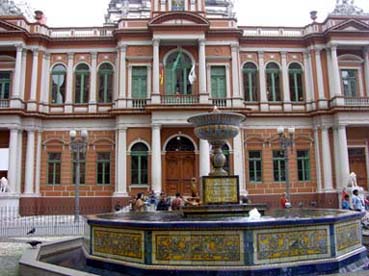 |
 |
One of the best known city landmarks, the old Usina do Gasometro, at left, remained closed for years, after it stopped being used as main city gas plant. After a complete restoration program, it is now one of major cultural places in the city, with library, movies theaters, restaurant, coffee shops and a gaucho art center. Located at 551 Joao Goulart Ave, it is open from Tuesdays to Sundays, 10 am to 10 pm.
|
Next to Usina do Gasometro there are tourist boats, offering one hour cruises on the Guaiba River. But if you would like a tip, we would suggest take the Cisne Branco Boat Tour (White Swan), which is the best. The departure point is 2 miles from Usina do Gasometro, at Praça da Alfandega, downtown. Get more info at the official web site Cisne Branco. |
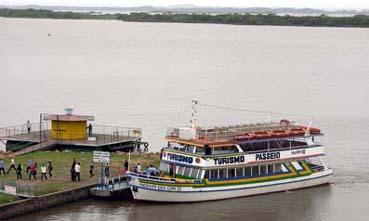 |

|
On sundays take a walk at Brique da Redencao, the best largest park in town also where you will fin an open air fair with antiques, hand made wooden items, leather, moderns and traditional themed paintings and much fun. At the park you can also rent a boat, bike, visit the mini zoo, practice some jogging or just walk. |
If you happen to visit Porto Alegre from december to march, you should now that almost the whole town moves do the Atlantic beaches. So why not join everyone and also head for the coast line? There are hundreds of beaches in Rio Grande do Sul state, some crowded, some quiet, some fashionable and some looking like forgotten places. It is up to you do decide which way to go, according to your mood. Actually, between Torres at north (right photo), and Chui (at south, Uruguai border), you will find just one beach, more than 300 miles long, and some say this is the longest continuous beach in the Americas. If you have some time to spare rent a 4W drive vehicle and discover for yourself all the wonders of the Gaucho coastline. |
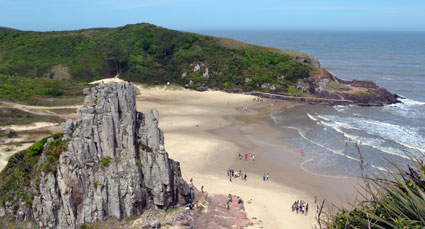
|
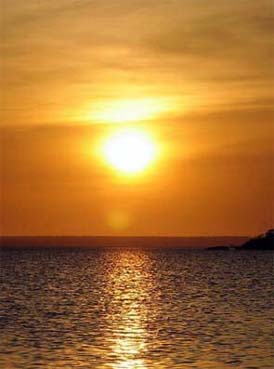
|
Porto Alegre is located at south Brazil, at the border with Uruguai and Argentina. From Rio de Janeiro, is one hour and 40 minutes flight. It has very hot summers and windy and cold winters. Some people say that in Porto Alegre you can feel, on the same day, the four seasons of the year. This is maybe a little too much, but the city has, indeed, very hot summers, cold winters (with even some snowing in the past), windy falls and all colored springtime. Maybe this unique weather helped to forge the gaucho life style. Since when this lonely rider used to live in the Pampa hills, having his horse as a best friend, and offering the visitors, as a gesture of friendship, a cup of hot Chimarrao.
In a certain way, you can say Porto Alegre didn’t change so much. Most of the gauchos are now urban types. Many of the hills are covered with large buildings. But if you look closer, you will see that deep inside this is still the same Gaucho Land. And Porto Alegre is still his lovely hearted home town. A friendly place, with a lot of fun and many exciting things to do. Not twice, but three times as cool as ever. Or, as the Gauchos use to say, Tri-legal. |
Video: Taking off from Porto Alegre.

|
|